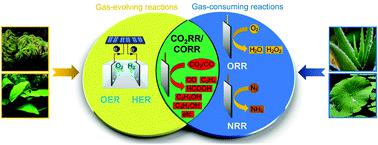当前位置:
X-MOL 学术
›
Chem. Soc. Rev.
›
论文详情
Our official English website, www.x-mol.net, welcomes your
feedback! (Note: you will need to create a separate account there.)
Wetting-regulated gas-involving (photo)electrocatalysis: biomimetics in energy conversion
Chemical Society Reviews ( IF 40.4 ) Pub Date : 2021-08-09 , DOI: 10.1039/d1cs00258a Guanyu Liu 1, 2 , William S Y Wong 3 , Markus Kraft 2, 4 , Joel W Ager 5, 6 , Doris Vollmer 3 , Rong Xu 1, 2
Chemical Society Reviews ( IF 40.4 ) Pub Date : 2021-08-09 , DOI: 10.1039/d1cs00258a Guanyu Liu 1, 2 , William S Y Wong 3 , Markus Kraft 2, 4 , Joel W Ager 5, 6 , Doris Vollmer 3 , Rong Xu 1, 2
Affiliation

|
(Photo)electrolysis of water or gases with water to species serving as industrial feedstocks and energy carriers, such as hydrogen, ammonia, ethylene, propanol, etc., has drawn tremendous attention. Moreover, these processes can often be driven by renewable energy under ambient conditions as a sustainable alternative to traditional high-temperature and high-pressure synthesis methods. In addition to the extensive studies on catalyst development, increasing attention has been paid to the regulation of gas transport/diffusion behaviors during gas-involving (photo)electrocatalytic reactions towards the goal of creating industrially viable catalytic systems with high reaction rates, excellent long-term stabilities and near-unity selectivities. Biomimetic surfaces and systems with special wetting capabilities and structural advantages can shed light on the future design of (photo)electrodes and address long-standing challenges. This article is dedicated to bridging the fields of wetting and catalysis by reviewing the cutting-edge design methodologies of both gas-evolving and gas-consuming (photo)electrocatalytic systems. We first introduce the fundamentals of various in-air/underwater wetting states and their corresponding bioinspired structural properties. The relationship amongst the bubble transport behavior, wettability, and porosity/tortuosity is also discussed. Next, the latest implementations of wetting-related design principles for gas-evolving reactions (i.e. the hydrogen evolution reaction and oxygen evolution reaction) and gas-consuming reactions (i.e. the oxygen reduction reaction and CO2 reduction reaction) are summarized. For photoelectrode designs, additional factors are taken into account, such as light absorption and the separation, transport and recombination of photoinduced electrons and holes. The influences of wettability and 3D structuring of (photo)electrodes on the catalytic activity, stability and selectivity are analyzed to reveal the underlying mechanisms. Finally, remaining questions and related future perspectives are outlined.
中文翻译:

润湿调节气体(光)电催化:能量转换中的仿生学
将水或气体与水(光)电解成用作工业原料和能量载体的物质,例如氢、氨、乙烯、丙醇等。,引起了极大的关注。此外,这些过程通常可以在环境条件下由可再生能源驱动,作为传统高温高压合成方法的可持续替代方案。除了对催化剂开发的广泛研究外,越来越多的关注在涉及气体的(光)电催化反应过程中调节气体传输/扩散行为,以期创造具有高反应速率、优异长效的工业上可行的催化体系。项稳定性和接近统一的选择性。具有特殊润湿能力和结构优势的仿生表面和系统可以阐明(光)电极的未来设计并解决长期存在的挑战。本文致力于通过回顾气体释放和气体消耗(光)电催化系统的前沿设计方法来弥合润湿和催化领域。我们首先介绍各种空气中/水下润湿状态的基本原理及其相应的仿生结构特性。还讨论了气泡传输行为、润湿性和孔隙率/弯曲度之间的关系。接下来,气体逸出反应的润湿相关设计原则的最新实现(还讨论了润湿性和孔隙度/曲折度。接下来,气体逸出反应的润湿相关设计原则的最新实现(还讨论了润湿性和孔隙度/曲折度。接下来,气体逸出反应的润湿相关设计原则的最新实现(即析氢反应和析氧反应)和耗气反应(即氧还原反应和CO 2还原反应)进行了总结。对于光电极设计,还考虑了其他因素,例如光吸收以及光生电子和空穴的分离、传输和复合。分析了(光)电极的润湿性和 3D 结构对催化活性、稳定性和选择性的影响,以揭示其潜在机制。最后,概述了剩余的问题和相关的未来前景。
更新日期:2021-08-09
中文翻译:

润湿调节气体(光)电催化:能量转换中的仿生学
将水或气体与水(光)电解成用作工业原料和能量载体的物质,例如氢、氨、乙烯、丙醇等。,引起了极大的关注。此外,这些过程通常可以在环境条件下由可再生能源驱动,作为传统高温高压合成方法的可持续替代方案。除了对催化剂开发的广泛研究外,越来越多的关注在涉及气体的(光)电催化反应过程中调节气体传输/扩散行为,以期创造具有高反应速率、优异长效的工业上可行的催化体系。项稳定性和接近统一的选择性。具有特殊润湿能力和结构优势的仿生表面和系统可以阐明(光)电极的未来设计并解决长期存在的挑战。本文致力于通过回顾气体释放和气体消耗(光)电催化系统的前沿设计方法来弥合润湿和催化领域。我们首先介绍各种空气中/水下润湿状态的基本原理及其相应的仿生结构特性。还讨论了气泡传输行为、润湿性和孔隙率/弯曲度之间的关系。接下来,气体逸出反应的润湿相关设计原则的最新实现(还讨论了润湿性和孔隙度/曲折度。接下来,气体逸出反应的润湿相关设计原则的最新实现(还讨论了润湿性和孔隙度/曲折度。接下来,气体逸出反应的润湿相关设计原则的最新实现(即析氢反应和析氧反应)和耗气反应(即氧还原反应和CO 2还原反应)进行了总结。对于光电极设计,还考虑了其他因素,例如光吸收以及光生电子和空穴的分离、传输和复合。分析了(光)电极的润湿性和 3D 结构对催化活性、稳定性和选择性的影响,以揭示其潜在机制。最后,概述了剩余的问题和相关的未来前景。










































 京公网安备 11010802027423号
京公网安备 11010802027423号